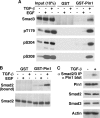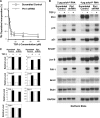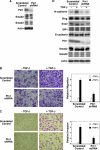Pin1 promotes transforming growth factor-beta-induced migration and invasion
- PMID: 19920136
- PMCID: PMC2804333
- DOI: 10.1074/jbc.M109.063826
Pin1 promotes transforming growth factor-beta-induced migration and invasion
Abstract
Transforming growth factor-beta (TGF-beta) regulates a wide variety of biological activities. It induces potent growth-inhibitory responses in normal cells but promotes migration and invasion of cancer cells. Smads mediate the TGF-beta responses. TGF-beta binding to the cell surface receptors leads to the phosphorylation of Smad2/3 in their C terminus as well as in the proline-rich linker region. The serine/threonine phosphorylation sites in the linker region are followed by the proline residue. Pin1, a peptidyl-prolyl cis/trans isomerase, recognizes phosphorylated serine/threonine-proline motifs. Here we show that Smad2/3 interacts with Pin1 in a TGF-beta-dependent manner. We further show that the phosphorylated threonine 179-proline motif in the Smad3 linker region is the major binding site for Pin1. Although epidermal growth factor also induces phosphorylation of threonine 179 and other residues in the Smad3 linker region the same as TGF-beta, Pin1 is unable to bind to the epidermal growth factor-stimulated Smad3. Further analysis suggests that phosphorylation of Smad3 in the C terminus is necessary for the interaction with Pin1. Depletion of Pin1 by small hairpin RNA does not significantly affect TGF-beta-induced growth-inhibitory responses and a number of TGF-beta/Smad target genes analyzed. In contrast, knockdown of Pin1 in human PC3 prostate cancer cells strongly inhibited TGF-beta-mediated migration and invasion. Accordingly, TGF-beta induction of N-cadherin, which plays an important role in migration and invasion, is markedly reduced when Pin1 is depleted in PC3 cells. Because Pin1 is overexpressed in many cancers, our findings highlight the importance of Pin1 in TGF-beta-induced migration and invasion of cancer cells.
Figures






Similar articles
-
Pin1 down-regulates transforming growth factor-beta (TGF-beta) signaling by inducing degradation of Smad proteins.J Biol Chem. 2009 Mar 6;284(10):6109-15. doi: 10.1074/jbc.M804659200. Epub 2009 Jan 4. J Biol Chem. 2009. PMID: 19122240
-
Peptidyl-prolyl cis-trans isomerase NIMA interacting 1 regulates skeletal muscle fusion through structural modification of Smad3 in the linker region.J Cell Physiol. 2018 Dec;233(12):9390-9403. doi: 10.1002/jcp.26774. Epub 2018 Aug 21. J Cell Physiol. 2018. PMID: 30132832 Free PMC article.
-
Oligodendrocyte transcription factor 1 (Olig1) is a Smad cofactor involved in cell motility induced by transforming growth factor-β.J Biol Chem. 2013 Jun 28;288(26):18911-22. doi: 10.1074/jbc.M113.480996. Epub 2013 May 17. J Biol Chem. 2013. PMID: 23720758 Free PMC article.
-
The metabolic crosstalk between PIN1 and the tumour microenvironment.Semin Cancer Biol. 2023 Jun;91:143-157. doi: 10.1016/j.semcancer.2023.03.001. Epub 2023 Mar 4. Semin Cancer Biol. 2023. PMID: 36871635 Review.
-
Transforming growth factor-β signalling: role and consequences of Smad linker region phosphorylation.Cell Signal. 2013 Oct;25(10):2017-24. doi: 10.1016/j.cellsig.2013.06.001. Epub 2013 Jun 11. Cell Signal. 2013. PMID: 23770288 Review.
Cited by
-
Down-regulation of HOXB5 inhibits TGF-β-induced migration and invasion in hepatocellular carcinoma cells via inactivation of the PI3K/Akt pathway.RSC Adv. 2018 Dec 11;8(72):41415-41421. doi: 10.1039/c8ra06860g. eCollection 2018 Dec 7. RSC Adv. 2018. Retraction in: RSC Adv. 2022 Sep 30;12(43):27996. doi: 10.1039/d2ra90097a. PMID: 35559288 Free PMC article. Retracted.
-
Prediction of gastric cancer metastasis through urinary metabolomic investigation using GC/MS.World J Gastroenterol. 2011 Feb 14;17(6):727-34. doi: 10.3748/wjg.v17.i6.727. World J Gastroenterol. 2011. PMID: 21390142 Free PMC article.
-
Cell signals influencing hepatic fibrosis.Int J Hepatol. 2012;2012:158547. doi: 10.1155/2012/158547. Epub 2012 Aug 29. Int J Hepatol. 2012. PMID: 22973518 Free PMC article.
-
Phospho-specific Smad3 signaling: impact on breast oncogenesis.Cell Cycle. 2012 Jul 1;11(13):2443-51. doi: 10.4161/cc.20546. Epub 2012 Jul 1. Cell Cycle. 2012. PMID: 22659843 Free PMC article. Review.
-
Identification of Prolyl isomerase Pin1 as a novel positive regulator of YAP/TAZ in breast cancer cells.Sci Rep. 2019 Apr 23;9(1):6394. doi: 10.1038/s41598-019-42767-w. Sci Rep. 2019. PMID: 31015482 Free PMC article.
References
-
- Roberts A. B., Sporn M. B. (1990) in Peptide Growth Factors and Their Receptors (Sporn M. B., Roberts A. B. eds) pp. 419–472, Springer-Verlag, Heidelberg, Germany
-
- Massagué J., Blain S. W., Lo R. S. (2000) Cell 103, 295–309 - PubMed
-
- Derynck R., Akhurst R. J., Balmain A. (2001) Nat. Genet. 29, 117–129 - PubMed
Publication types
MeSH terms
Substances
Grants and funding
LinkOut - more resources
Full Text Sources
Molecular Biology Databases
Research Materials
Miscellaneous

